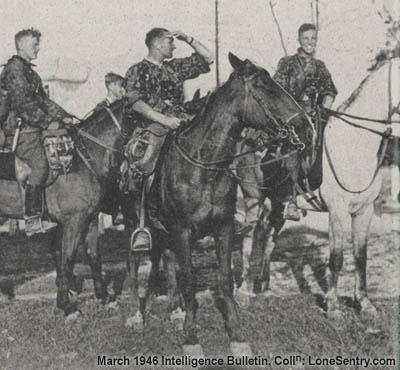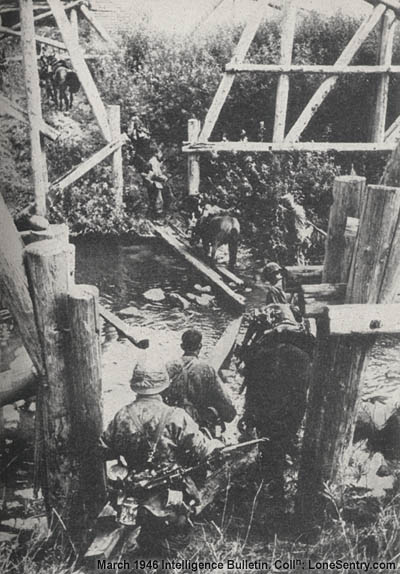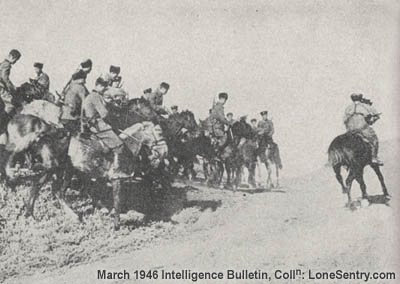Exactly. AS TRANSPORTATION, not as viable military units. The U.S. still looked at cavalry charge as a viable military tactic in the late 30's and early 40's.
Where do I begin? The German army used cavalry units from the beginning of the war until their surrender in 1945. Below is a list of the German cavalry units.
1st Cavalry Division (later 24th Panzer Division)
3rd Cavalry Division
4th Cavalry Division
Cossack Cavalry Division (unit was transferred to the Waffen-SS, where it was split to form the 1st & 2nd Cossack Cavalry Divisions as part of the XV SS Cossack Cavalry Corps)
Most remember stories of the famous cavalry charges by the Polish army during the Invasion of Poland, but what is not as well known are the two cavalry charges by the German army.
Królewskie Forests near town Krzynowłoga Mała - 01.09 - Polish - German cavalry horse fierce skirmish - German cavalry horse charge with sabres:
Small Polish patrol from 11th Leggionary Ulan Regiment (Mazowiecka Cavalry Brigade) under command of lieutenant Wladislaw Kossakowski during the reconessaince mission, met small German cavalry patrol from 1st Cavalry Brigade. Kossakowski decided to start a battle - close combat with sabres and probably lances on Polish side (this was one of a few incidents during the campaign, when Polish cavalry used lances), and with sabres on German side.
Kossakowski wrote:
"At the end of our march, in the edge of small forest clearing, we saw small German cavalry unit. They didn't see us, but their positions were crossing the road and blocking our march direction. I asked other officers - are we charging? As the answer, I heard noice of sabres being pulled out from sheaths. We made a pre-charge formation and charged towards them from the forest, screaming - Hurray! The shock tactic was succesfull, but - what surprised us - this time German cavalry didn't panic or withdraw, but re-charged us using sabres - also screaming Hurray! and occasionally - Heil Hitler! - two brave charging cavalry units, screaming, brandishing with sabres and bending down in saddles, were going to head-on collision! After few seconds, we reached them and they reached us. Two cavalry formations crushed in one battle - but our impetus was greater. In fact, both formations just passed each other - but there were casualties on both sides. I remember, that corporal Juckiewicz stuffed a German cavalryman with his lance - German soldier just moaned and died. After this short but fierce and bloody combat, we galloped in our way and those of Germans who survived - galloped in their way. We were all unconcsious from emotions and excitement, but kept riding - after few minutes we reached our infantry with MGs and mortars positions - great relief. Finally, our patrol joined our regiment in the late evening"
Charge by Krasnobród - 23.09.1939:
2nd Polish cavalry squadron (from 25th Cavalry Regiment) is attacking (in foot formation) German infantry - hand granades, rifles and MGs, together with artillery support (9th Horse Artillery Command) force German infantry to withdraw in great mess. German chaotic and fast withdrawal makes an opportunity to make a cavalry charge:
Other Polish cavalry unit (1st squadron under command of lieutenant Tadeusz Gerlecki) is charging and chasing panicked German Infantry which is now running away, crushed and completely disorganized - one squadron of German heavy "Eastern Prussian" cavalry with strong, heavy horses, charge with sabres towards Polish cavalry, trying to rescue rests of defeated German Infantry:
"It was amazing view - against Polish ulans charged German cavalry units - Polish squadron - charging in a single line formation - with lances directed towards Germans, was closing to the charging enemy. Enemy cavalry was charging with sabres in chaotic, messy formation. Finally, units striked each other. Polish cavalry - well disciplined, better trained for horse fighting and supported by Polish 9th Horse Artillery Command - crushed Germans. Polish sabres together with Polish artillery fire, crushed Prussians - German cavalry suffered heavy losses."
Prussian cavalry was also charging against 2nd squadron positions, which was defending in foot formation with MGs and rifles - German charge was rejected (mainly because of Polish artillery support and MGs fire) with quite heavy losses for them. But there is no doubt, that German cavalry charge gave the minute of peace to the Infantry, and help in its withdrawal, giving an opportunity to rest for a few minutes without being attacked, decrease panic, and - partially - regroup.
Polish cavalry attack supported infantry, and inficted on re-taking the city of Krasnobród from German hands, and capturing the headquarters & staff of German 8. Infanterie-Division together with many divisional commanders and staff officers.
There was also a Waffen-SS cavalry division, the 8th SS Cavalry Division Florian Geyer.
Insignia of the 8th SS Cavalry Division

German soldier of the 3rd Cavalry Division adjusting the bridle on his horse.

Soldiers of the 8th SS Cavalry on the Eastern Front.

Members of the 8th SS Cavalry crossing a stream in Russia.

2nd Cossack Cavalry troop forming up prior to a charge.

In contrast, by the beginning of the war the US Army was already disbanding their horse cavalry units and reorganizing them as mechanized units and the last US cavalry charge took place in 1942 in the Philippines.
So, you were saying?
ack-ack